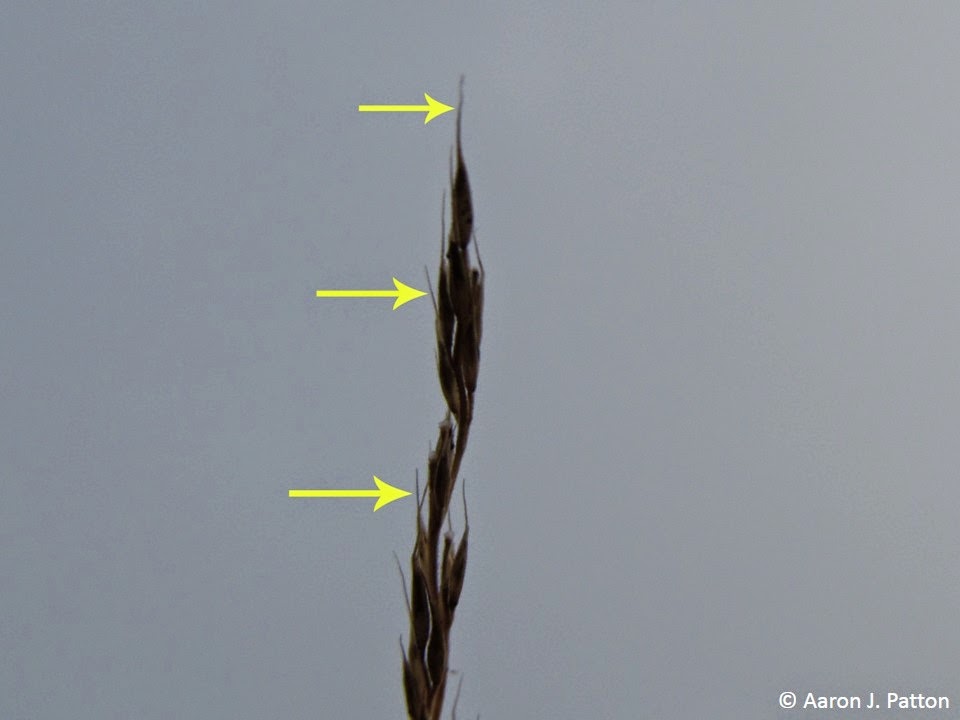Nimblewill
Biology: Nimblewill (Muhlenbergia schreberi) is a warm-season perennial grass found throughout the northeast, southeast, and Midwestern United States. It can often be mistaken for other mat-forming grasses with blue-green foliage such as bermudagrass or creeping bentgrass. It grows well in moist, shady areas but it is also found in dry, sunny areas. Nimblewill spreads vegetatively through short, weak stolons and creates patches in lawns that start off small, but then grow into larger patches.
Identification: Nimblewill forms mat-like patches in lawns as it spreads radially via short, weak stolons. It is usually distinguishable in cool-season lawns from its gray-green, coarse textured leaves. Nimblewill patches may be observed during the summer months as cool-season lawns are stressed by heat and drought. It is also easily distinguishable as brown, dormant patches surrounded by green cool-season turf during the winter months. It is often confused with bermudagrass, but has a short, jagged, membranous ligule compared to a hairy ligule on bermudagrass. Nimblewill often produces loose, spike-like panicles in late summer to early fall. Seeds on the seedhead will have long, hair-like awns that help further distinguish nimblewill from bermudagrass.
 |
| Nimblewill has short, pointed leaves |
 |
| Nimblewill seedhead |
 |
| Nimblewill seedhead with arrows pointing to awns |
 |
| Dormant nimblewill in a shady lawn. Small patches grow together to form large areas. |
 |
| New growth in the early spring |
 |
| Dormant patch of nimblewill in the spring during greenup. |
 |
| New growth in the early spring |
 |
| Nimblewill leaves (center) in a cool-season lawn |
 |
| Blue-grayish colored nimblewill leaves (Center) in a cool-season lawn |
 |
| Patches of nimblewill that are green during drought. Nimblewill is drought tolerant as shown in this photo. |
Nimblewill will have a membranous ligule and sparse hairs and bermduagrass has a hairy ligule and is usually very hairy.
 |
| Nimblewill has a small membranous ligule |
Cultural control: The use of cultural practices, such as increased mowing height, fall fertilization, and overseeding to enhance cool-season turf density and vigor may help the lawn to outcompete nimblewill infestations.
Biological control: None known for specific use in nimblewill.
Chemical control: There are nonselective and selective control options available for nimblewill. Usually, stoloniferous, perennial grasses are controlled by spot-treating with a nonselective systemic herbicide such as glyphosate (Roundup). For best results, apply when the plants are young and actively growing. However, because nimblewill is capable of re-establishing through surviving stolons, at least two glyphosate applications are recommended, but three or more may be needed for complete eradication. It is important to allow the weed to regrow before making any follow-up applications.
Two new herbicides provide selective control options for nimblewill in cool-season turf. These herbicides are applied at relatively low use rates and homeowners are encouraged to hire lawn care professionals to make applications.
Mesotrione (Tenacity) can be used for selective control of nimblewill growing in a cool-season turf. To control nimblewill, start applying mesotrione in the spring (late-April) with a nonionic surfactant at 0.25% (v/v). You will need to make two or three applications. If you make three applications, use the 5 fl oz/A rate (or 6, 6 and 4 fl oz/A). The product does have a yearly maximum use rate, and the label states “do not apply more than 16 oz of Tenacity per acre per year or per crop (equivalent to a maximum of 0.50 lb of mesotrione per acre per year).” You can also apply mesotrione in late summer and fall, but you should initiate them by August for best results.
Another option is to apply topramezone (Pylex) at 1-1.5 fl oz/A at 21- to 28-day intervals starting in late April. For best results, include a methylated seed oil at 0.5-1.0% (v/v).
Aaron Patton, Turfgrass Extension Specialist
Leslie Beck, Postdoctoral Research Associate
